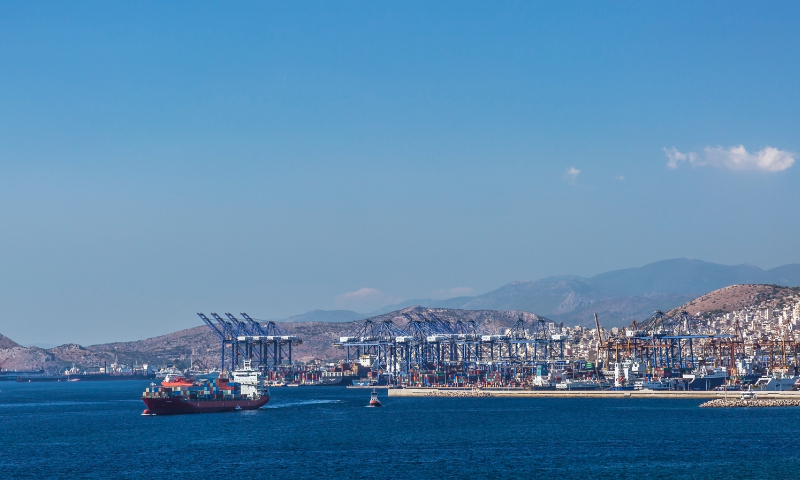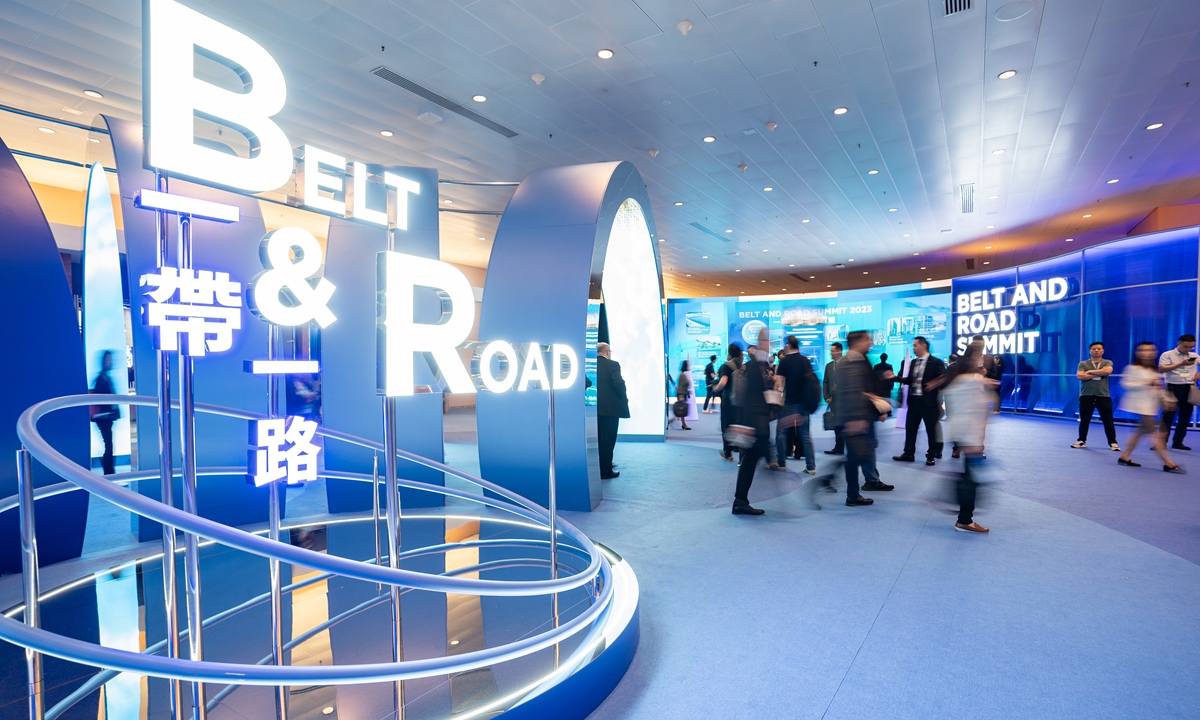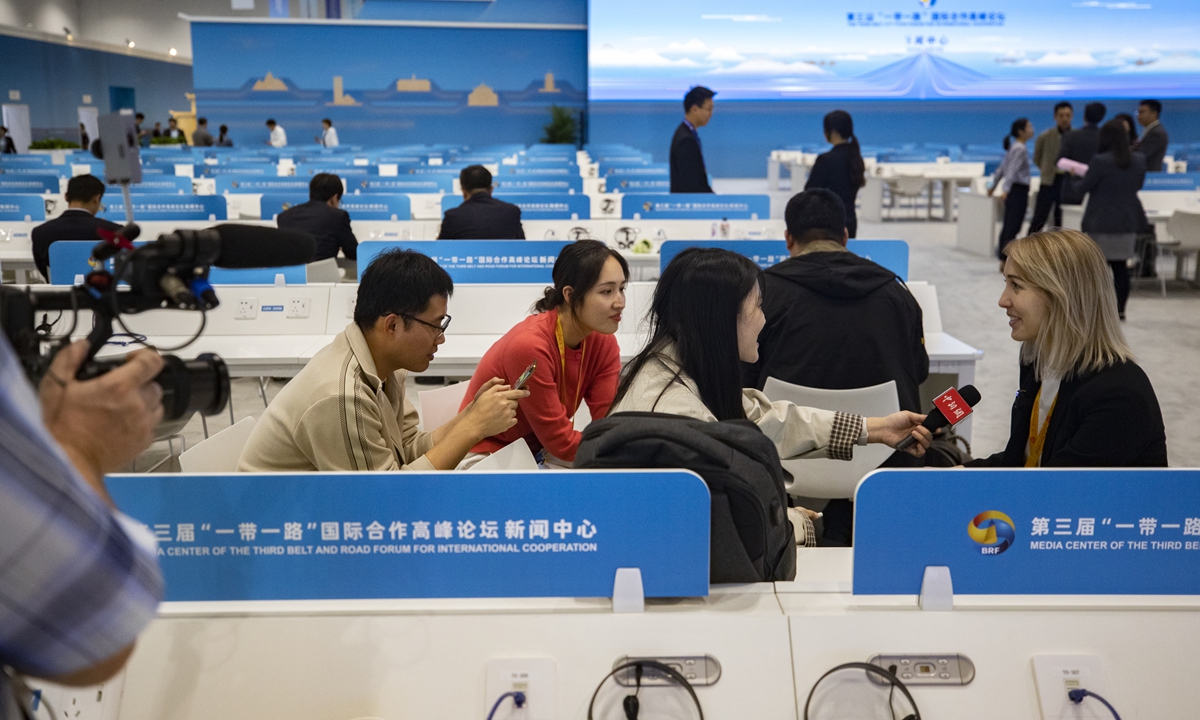BRI: A global project of the century, a path to global well-being
Ten years of miraculous BRI development turns the aspiration of people for a better life into reality
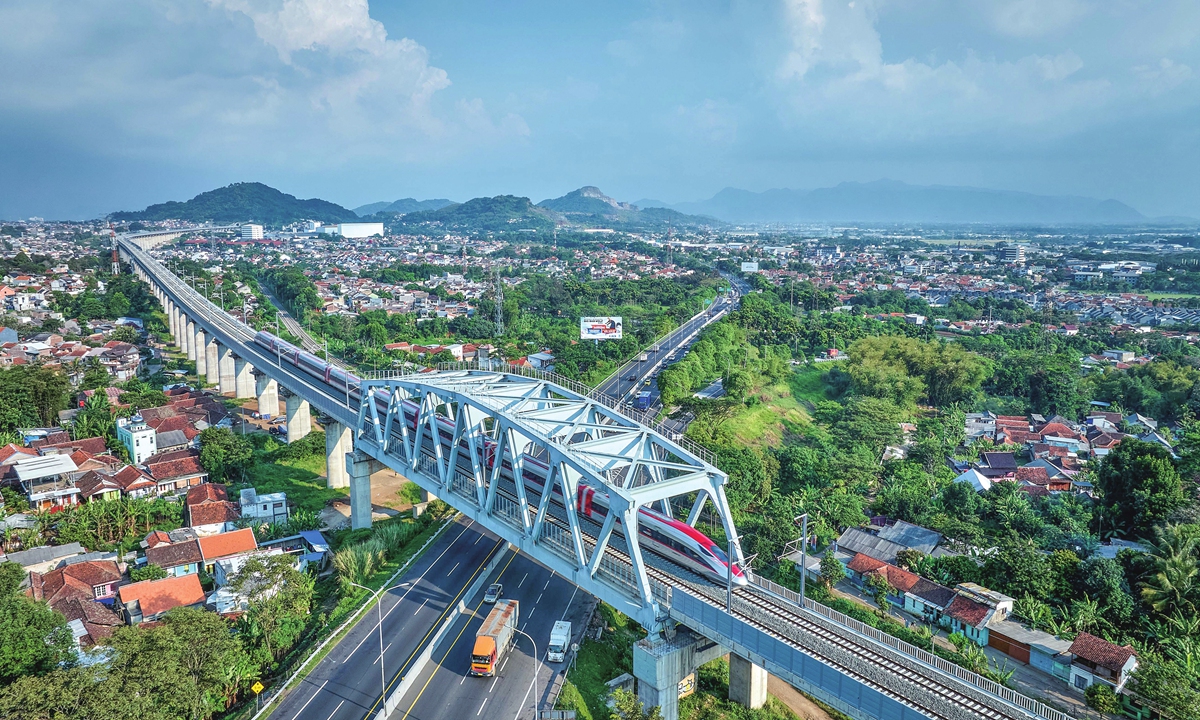
A view of the Jakarta-Bandung High-speed Railway Photo: VCG
Editor's Note:
China is holding the third Belt and Road Forum for International Cooperation (BRF) from October 17 to 18 in Beijing, marking a milestone in the development of the Belt and Road Initiative (BRI) at its 10th anniversary. Ten years ago, Chinese President Xi Jinping unveiled his proposal to jointly build the Silk Road Economic Belt and the 21st Century Maritime Silk Road, known as the Belt and Road Initiative. It was a transformative vision at that time in response to a changing global situation, and with the future and overall interests of humanity in mind.
Over the past decade, BRI has turned from ideas into actions, from a vision into reality, and from a general framework into the largest international cooperation platform with the broadest coverage of any comparable project. And the significance of the initiative, aligning with the ultimate goal of building a global community of shared future, also has been enriched and rises to a new height as the "world today is going through profound changes on a scale unseen in a century." One of the most significant contributions of BRI, according to a white paper on the BRI issued last week, is to open up "a path to global well-being."
To decipher how the China-proposed initiative has provided both a conceptual framework and a practical roadmap for all nations on the path to global wellbeing, the Global Times is publishing this special edition as a celebration of a remarkable decade of achievement under the BRI as the BRF is being held. The special edition will also visualize the embodiments of "a path to global well-being," which incorporates peace, prosperity, openness, innovation and social progress, demonstrating the "global project of the century" also has illuminated a path of hope for humanity toward a brighter future.
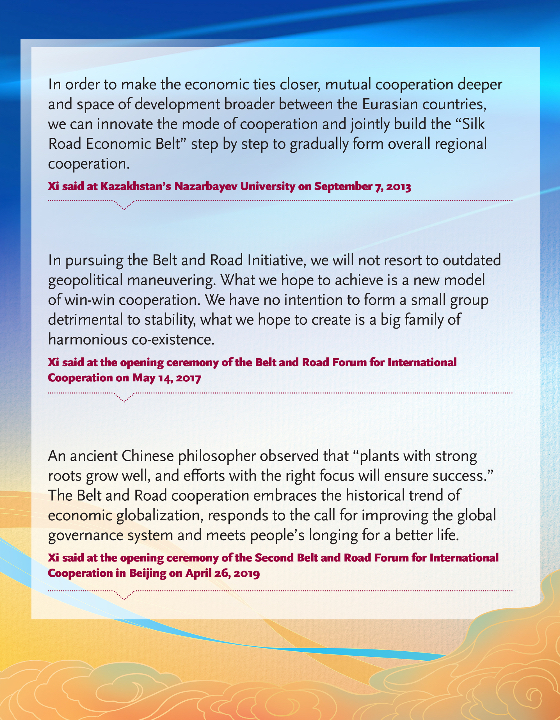
In a whistle, the "Whoosh" of the Jakarta-Bandung High-speed Railway (HSR) roared past Grace Jessica, a 20-something Indonesian, at a speed of 350 kilometers an hour, swirling up a breeze that gently fanned her cheek.
"The beautiful day for a speedy ride arrived," Jessica told the Global Times, as she stood under a glass dome at the Tegalluar station in Bandung, where the sunlight brightened her smile.
Jessica's voice was full of excitement and pride, and what thrilled her was the realization of Indonesia's decade-long high-speed railway dream, which has finally morphed into reality with the implementation of the landmark Belt and Road Initiative (BRI) project, at the 10th anniversary of the initiative.
With Indonesian President Joko Widodo pressing the HSR's opening button at Halim Station on October 2, the "Whoosh," whose name was inspired by the sound of the train, has earned Indonesia the title of becoming the first Southeast Asian country operating HSR at a speed of 350 kilometers an hour.
The inauguration of the BRI project marks an epoch-making moment to the applause and celebration of all Indonesians, as well as Southeast Asia, a region mostly composed of developing countries which are in dire need to fill the infrastructure gap. The red-white bullet train, passing through the economic hinterland of Indonesia also offers a fresh glimpse into the fruitful BRI global cooperation in the past ten years, which has turned the aspiration of people in countries participating in the initiative for a better life into reality.
Back to 2013, Chinese President Xi Jinping proposed that China and ASEAN countries build a 21st Century Maritime Silk Road and foster a closer China-ASEAN community with a shared future at a key speech delivered at the Indonesian parliament during his visit to the Southeast Asian country. The initiative, together with the "Silk Road Economic Belt" proposed by Xi in Kazakhstan in 2013, marked the start of a groundbreaking vision that has ushered the world into a path to global well-being.
"Ten years ago, I proposed the BRI, and on its tenth anniversary, China will hold the third Belt and Road Forum for International Cooperation… We should work together to broaden the Belt and Road as a 'path of happiness' benefiting the whole world," according to an address by Chinese President Xi Jinping at the 23rd Meeting of the Council of Heads of State of the Shanghai Cooperation Organization via video in July.
The third Belt and Road Forum for International Cooperation is being held in Beijing from October 17 to 18. Xi will attend the opening ceremony of the forum and deliver a keynote speech. The monumental gathering is being convened at a historical junction that is deemed as both a milestone and a new start of BRI cooperation.
Over the past decade, no other proposal in the modern history has attracted the participation of such large number of countries in such a short time and generated widespread international influence that can be compared to the BRI.
As the world faces geopolitical and economic roadblocks, the BRI's extraordinary role in promoting all-rounded connectivity has proven it to be a visionary platform that led the world to navigate through the mist into a voyage to "peace, prosperity, opening-up, innovation and connecting different civilizations," all of which compose the dynamic encompassing meanings behind Xi's call for a "path of happiness."
The ten years of international joint effort in building the BRI, developing hand in hand with Xi's vision on "building a community with a shared future for mankind," has also paved the way for a revolutionary global axis under which developing countries are encouraged to strive for a better future and improve the international fairness rather than "a small Western hegemonic clique" predominating the order, Chinese and foreign scholars noted.
Standing at the BRI's 10th anniversary, the initiative is set to continue to gain global endorsement as a revolutionary and effective framework, in contrast to the Western geopolitical power wrestling that endangers globalization and world peace, they noted.
A road to common development
"If we look at the map of transportation communication before BRI's creation and ten years after, there's a huge difference," Bolat Nurgaliyev, former secretary-general of the Shanghai Cooperation Organisation (SCO), told the Global Times, referring to an overarching transportation network being built as part of the BRI which has delivered enormous benefits to Kazakhstan and other Central Asian countries.
In Horgos, Northwest China's Xinjiang Uygur Autonomous Region which borders Kazakhstan, it now only takes less than six hours for freshly-picked fruit to be delivered to the Kazakh market via a China-Europe freight train and sold to the local consumers. Before the BRI transportation network was established, the shipping time was two or three days.
Gulnar Shaimergenova, Director of China Studies Center, Kazakhstan who participated in the event when President Xi first proposed the Silk Road Economic Belt, told the Global Times that the implementation of the BRI is "strategically and economically beneficial for Kazakhstan," as up to 80 percent of the China-Europe rail routes pass through Kazakhstan, through which the inland country is connected with 200 cities in 25 European countries as well as more than 100 cities in 11 Asian countries and regions.
Looking southward, more than 80 percent of Kazakhstan's major trade commodities such as mineral products and grains are exported via Lianyungang port in East China's Jiangsu Province, from where those goods are assembled and shipped to over 200 international markets. The transportation arrangement is under a logistics cooperation link between China and Kazakhstan launched in 2014, also the first entity project under the BRI.
The BRI has transformed landlocked countries like Kazakhstan not only to being "land-linked," but also "maritime connected," further opening their doors to global markets.
There is no shortage of similar stories showcasing the profound changes the "global project of the century" has been unfolding and how it meets people's longing for a brighter future.
In Europe, BRI investment reinvigorated the Port of Piraeus and modernized the Budapest-Belgrade railway; In Africa, BRI cooperation put the Addis Ababa-Djibouti Railway into operation, marking the very first electrified railway in the continent. Likewise, the BRI has so far established more than 3,000 cooperation projects, galvanized nearly $1 trillion of investment and created 420,000 jobs for local communities.
"For the first time in history, an unprecedented plan for the formation and development of an interconnected transportation infrastructure across the entire Eurasian continent was presented. Its implementation truly opened up broad prospect for the creation of a fundamentally new transport configuration across the vast expense of our planet," Saidmukhtar Saidkasimov, former Uzbek deputy prime minister and former minister of Foreign Affairs, told the Global Times.
According to a BRI white paper released last week, the BRI has become the world's largest platform for international cooperation with the broadest coverage in the past 10 years. More than three quarters of all countries in the world and over 30 international organizations have signed Belt and Road cooperation documents with China.
"If the world looks for balanced globalization, the key issue is to shore up the growth of developing countries. If developing countries want to fast track development, they need to be integrated into the global logistics and supply chain network. They need to enhance economic self-reliance, rather than relying on foreign assistance," Wang Yiwei, director of the Institute of International Affairs at the Renmin University of China, told the Global Times.
That's how the China-proposed initiative fueled common development, helped the Global South to realize their potential, and thereby enhanced the sense of fulfillment and happiness for people of participating countries, industry insiders said.
The BRI for the first time gave the Global South a very concrete perspective to overcome poverty and underdevelopment "on their feet," Helga Zepp-La Rouche, founder of Germany-based political and economic think tank the Schiller Institute, told the Global Times.
A spokesperson from the China Railway No.4 Engineering Group Co, a main contractor behind a number of flagship BRI projects including the Jakarta-Bandung HSR, told the Global Times that BRI cooperation aligns with the development needs and strategies of partner countries, while leveraging each other's advantage to a full play, which is why the initiative is dubbed as "a road to joint prosperity."
According to a report by the World Bank, the construction of the BRI has increased trade among participants by 4.1 percent and raised the GDP of low-income countries by 3.4 percent. Benefiting from the BRI, the GDP share of emerging and developing economies increased by 3.6 percentage points from 2012 to 2021.
Fostering a global spirit of openness
In an address to the Boao Forum for Asia Annual Conference in 2015, President Xi highlighted several underpinning principles of BRI, including openness and inclusiveness. "They [BRI] will be a real chorus compromising all countries along the routes, not a solo for China itself," Xi noted.
From the date of its creation, the BRI carries forward the century-long "Silk Road spirit," with advanced concepts responding to the calls of the time for peace, development and win-win cooperation and dynamic adaption to "great changes unseen in a century."
"The BRI connects the past, the present and the future. This initiative was launched by China, but it belongs to the world and benefits the whole of humanity," reads the white paper on BRI.
Many observers have called BRI as a new globalization tide shepherded by China that lives up to the global dream for a better future of humanity.
"BRI goes beyond just facilitating connectivity, promoting trade and investment. It has fostered a global perspective of openness, which carries deeper importance in light of the current international landscape that is clouded by camp confrontation and geopolitical tensions," He Weiwen, a senior fellow and executive council member of China Association of International Trade, told the Global Times.
In a world of "de-risking" and politically induced supply chain fragmentations being orchestrated by the US, the initiative has not only helped maintain global peace and stability but also serves as catalyst for inching more cooperation between participating countries, with some being inked even without China's presence, the analyst said.
He noted that the creation of African Continental Free Trade Agreement, the largest free trade area in the world measured by the number of participating countries signed in 2019, is a vivid display of the indigenous spirit of openness and inclusiveness championed by BRI.
The World Bank estimates that by 2030, the construction of the BRI will generate annual benefits of $1.6 trillion for the world, accounting for 1.3 percent of global GDP, which would offer a timely shot in the arm to bolster economic globalization. The bank has estimated that by 2030, BRI-related investment could lift 7.6 million people out of extreme poverty and 32 million out of moderate poverty.
Xi emphasized in his keynote delivered on the opening ceremony of the second BRF that "the Belt and Road cooperation embraces the historic trend of economic globalization, responds to the call for improving the global governance system, and addresses people's desire for a better life."
In a divergence with China, the US always is bound by the mentality of unilateralism and obsessed with hegemony, thus it has already shackled the development of the world, said John Ross, a senior fellow at Chongyang Institute for Financial Studies, Renmin University of China and former director of economic and business policy for the Mayor of London.
Observers noted that in order to seek for development, to pursue national interest, countries are trying to be free of the US-dominated international system and that Chinese wisdom is being shown to be a more suitable model.
"Those countries craving for development and for freeing from the US shackles need to work together. Their desires have laid the foundation for BRI and expansion of BRICS. That is why those initiatives and organizations are so much more stable than the US believes," Ross said.
"The Western countries' logic is that a country must seek hegemony once it becomes stronger, but the BRI is the opposite," said Wang Wen, professor and executive dean of Chongyang Institute for Financial Studies at Renmin University of China.
Reactive to the achievements of the BRI, some foreign media have hyped the BRI as China "seeking hegemony." In an article titled "BRI and hegemony with Chinese characteristics" published by Indian media the Hindustan Times in April, it said that "The BRI is thus a perfect tool for strategic takeovers and for attaining hegemony of the international system."
International political interest is a battle for benefits according to Western discourse, but China focuses on cooperation and mutual benefit no matter how Western politicians and media vilify the initiative, observers said. Wang noted that BRI, with the ultimate goal of building a community with a shared future for mankind, provided a more civilized future.
Observers also expected that the upcoming BRF at the 10th anniversary of the BRI will chart out a new course for amassing the role of BRI in bringing peace to the world amid rising geopolitical tensions.
While a ten years is just a prelude to a new chapter of high-quality BRI cooperation, it is of no doubt that people in the BRI partner countries are confidently embarking on a "sunshine boulevard" that offers new approaches to international exchanges, rather than "a private path owned by any single party" that leads the world to an dead-end.
Where will this journey head them to? The answer could lie in the upcoming BRF. But maybe as the white paper illustrated, to "an open, inclusive, clean, and beautiful world that enjoys lasting peace, universal security and common prosperity," and "a bright future for human development" as well.


